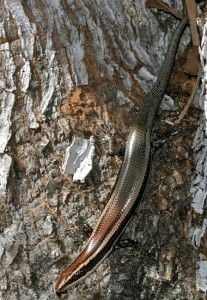24 New Lizard Species Discovered, Half Close to Extinction
The discoverer of the world’s (then) smallest frog, snake and lizard does it again with new species of Caribbean skinks
/https://tf-cmsv2-smithsonianmag-media.s3.amazonaws.com/filer/Anguilla_Bank_lizard_header.jpg)
We live in an age of alarming extinction, in which many species are lost in large part due to human activity. At the same time, the natural world is so complex that even after centuries of research, scientists are still rapidly discovering new species everywhere from mountain tops to rain forests to the ocean floor.
This paradox is aptly illustrated by an announcement made yesterday: 24 new species of lizards, known as skinks, have been discovered in the Caribbean islands. But half of them may be close to extinction, and some may already extinct in the wild.
The research was conducted by a team led by Blair Hedges, a biologist at Penn State University and one of the world’s foremost experts at identifying new forms of life. Previously, Hedges has been involved with the discovery of what were then the world’s smallest snake, lizard and frog. The two dozen species named in this paper, published in the journal Zootaxa, constitute one of the largest mass discoveries of lizards in centuries.
To identify the many species of skinks (formally, members of the family Scincidae), Hedges and his team examined specimens housed at zoos and conservation centers around the world. By comparing taxonomic features of the lizards (such as the shapes of scales) and using DNA analysis, they determined that there are a total of 39 distinct species of skinks that live in the Caribbean—6 species that were previously recognized, 9 that had been named long ago but had been considered invalid and the 24 entirely new ones.

“Now, one of the smallest groups of lizards in this region of the world has become one of the largest groups,” Hedges said in a press release. “We were completely surprised to find what amounts to a new fauna, with co-occurring species and different ecological types.” He has determined that the skinks came to the Americas roughly 18 million years ago, likely arriving from Africa on floating rafts of vegetation.
How did the skinks go unnoticed for so long? Hedges speculates that because large numbers of skinks had already disappeared by the start of the 20th century, scientists, tourists and local residents have been much less likely to encounter them in the years since. Additionally, many of the characteristics that distinguish the species from one another have been overlooked or weren’t detectable until now, especially those indicated by DNA analysis.
The researchers determined that the skinks have long been most threatened by an exotic intruder: the mongoose, introduced from India to Cuba in 1872 with the intention of reducing rat populations in sugarcane fields. Rat populations were partially controlled, but by 1900, nearly half of the islands to which the mongoose had spread were also without skinks, and the remaining lizards have dwindled in population ever since. Additionally, the researchers note, current human activities such as forest removal are likely contributing to the skinks’ endangered status. The research team hopes that their data will be used to plan future conservation efforts.
Theoretically, if you’re in the U.S. Virgin Islands, Trinidad and Tobago, or Martinique, you might try looking for a skink. But because each of the species is remarkably rare—with even the non-endangered ones qualifying as vulnerable—it’ll certainly be difficult. Above all, if you do want to find one, hurry up: there may not be much time left.
/https://tf-cmsv2-smithsonianmag-media.s3.amazonaws.com/accounts/headshot/joseph-stromberg-240.jpg)
/https://tf-cmsv2-smithsonianmag-media.s3.amazonaws.com/accounts/headshot/joseph-stromberg-240.jpg)